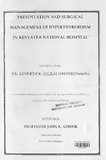| dc.contributor.author | Sigilai, Kenneth | |
| dc.date.accessioned | 2013-05-24T06:48:11Z | |
| dc.date.available | 2013-05-24T06:48:11Z | |
| dc.date.issued | 2003 | |
| dc.identifier.citation | Masters of Medicine (Surgery) | en |
| dc.identifier.uri | http://erepository.uonbi.ac.ke:8080/xmlui/handle/11295/25104 | |
| dc.description.abstract | Hyperthyroidism is the second. commonest endocrine disease seen in Kenyatta
National Hospital (KNH), second only to diabetes mellitus. Every year about
forty new patients with hyperthyroidism are recruited in the thyroid clinic while
another fifty-seven undergo thyroidectomy for various forms of goitres,
majority whom are hyperthyroid.
Though anecdotal evidence point to diffuse goitre as the main cause of
hyperthyroidism, no survey has been done to classify the clinical presentation,
surgical management and outcome of various hyperthyroid states as seen in
KNH.
A ten-year retrospective study was designed to look into the presentation of
hyperthyroidism as seen in KNH and subsequent surgical management.
Outcome was assessed for the immediate post operative period and up to oneyear
post operatively.
The Main Findings Were:
The disease is more common in females with a male: female ratio of 1:4.2 and
peak incidence at 37 years. Gravels disease affects a younger population with
average age of 31 years while Toxic Multinodular Goitre occurs in people 10
years older.
The commonest presenting symptoms were a neck swelling, heat intolerance
and palpitations while the main clinical signs were goitre, tachycardia and
exophthalmos. | en |
| dc.language.iso | en | en |
| dc.publisher | University of Nairobi | en |
| dc.title | Presentation and surgical management of hyperthyroidism in Kenyatta National Hospital | en |
| dc.type | Thesis | en |
| dc.description.department | a
Department of Psychiatry, University of Nairobi, ; bDepartment of Mental Health, School of Medicine,
Moi University, Eldoret, Kenya | |
| local.publisher | School of Medicine | en |

